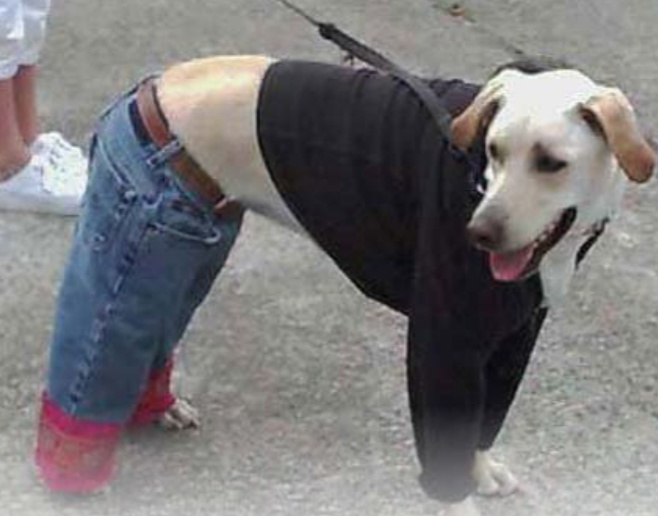“Why do humans wear clothes but not animals?
We’re not. The hermit crabs that others have mentioned are a good example to the contrary. Another one that I studied when was a kid first getting into science is caddisfly larvae. They stitch together “shirts” and “pants” for themselves out of silk and bits of gravel, shell, sticks, and (in the experiments I did) bits of glass and plastic.
Here’s another insect, the wooly alder aphid, that makes “clothes” for itself.
Just like us, these other species “wear clothes” to protect themselves from the elements and to be less vulnerable. Unlike us, they’re not much into nylon or rayon, but they do have
Humans wear clothes because we are clever enough and have enough manual dexterity to make them, and because we lack fur but have chosen to migrate away from our original habitat that we were adapted to being naked in. Once we started covering parts of our bodies, that created the idea of modesty and shame, so now going completely naked seems like a big deal even though it’s our natural state.
Animals tend to live in the climate that suits them, so they don’t need clothes. But they couldn’t make them even if they did. However, just like humans, animals can and do seek shelter at times.
Humans wear clothes for several reasons that are largely cultural, social, and practical, while animals do not typically wear clothes due to their natural adaptations. Here are some key points to consider:
Reasons Humans Wear Clothes:
Protection: Clothing protects against environmental elements such as cold, heat, rain, and sun. It can also protect against physical injuries.
Modesty and Social Norms: Many cultures have developed norms around modesty, leading to the widespread practice of covering certain body parts.
Identity and Expression: Clothing can serve as a form of personal expression, allo
Because you restrict your definition of ‘clothes’ to things people wear. Hermit crabs wear the shells of other animals.
“As the hermit crab grows in size, it must find a larger shell and abandon the previous one. This habit of living in a second-hand shell gives rise to the popular name “hermit crab”, by analogy to a hermit who lives alone.
Several hermit crab species, both terrestrial and marine, have been observed forming a vacancy chain to exchange shells.
When an individual crab finds a new empty shell it will leave its own shell and inspect the vacant shell for size. If the shell is found to
I will try to answer this question with a chapter from my book on human evolution (“A New Model of Human Evolution” LAP, 2017). Sorry if the answer is too long, and also, please, mind that this is my personal answer to this interesting question.
Clothes: For cold or for a show?
Many readers would agree that the most effective means to change one’s appearance is the use of clothes, or when put more broadly the use of external subjects covering one’s body. We look out of the window to see the weather conditions and accordingly decide which clothes we should put on. Choosing clothes also depends on
Original Question: Why are humans the only animal that wear clothes?
I think how one answer’s the question depends on how one thinks about the purpose of “clothes.” If you consider the idea of “clothes” from the perspective of purpose, (the “why” of your question), the behavior is not a uniquely human one. Of the five reasons humans wear clothes, several are reflected in (or perhaps inherited from) other species.
Protection
If you subscribe to the idea that clothes are made for protection, such as fur coats to protect against the cold, humans are not unique in this capacity. Consider hermit crab
We aren’t. Think of caddis flies for example, and there are hermit crabs who “wear” sea anemones. Afaik we’re the only animals who make clothes in a way more elaborate than just gluing bits on, but that’s mainly because we have the best hands.
Some animals certainly like to decorate and protect themselves the best they can with what they have.


